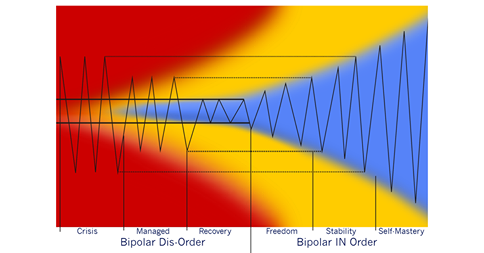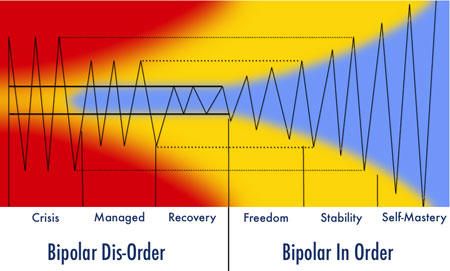- in Results by Tom Wootton
The Six Stages Of Bipolar and Depression

Moving From Bipolar Disorder to Bipolar IN Order
Everyone has up and down times. It is a natural part of life. If we observe our lives over time we might say there are two poles that we have; some days we feel on top of the world and other days perhaps on the bottom. That is the basis for the word bipolar and the reason I say that everyone is bipolar. Some may argue that there are people who are unipolar and only experience the up or down side, but even they have a range of experience with a “pole” on each end.
Unfortunately, the word bipolar is generally used to describe a subset of people who have adverse reactions when they go to far toward the high and low poles. Although related to how far from center one is, there is no distance from center that guarantees one would necessarily react to it in an adverse way. It really depends on how far we are from our comfort zone. One person might be perfectly comfortable and highly functional at a certain point from center while another could be so uncomfortable that he/she is literally in danger of suicide. I see the comfortable person as keeping life in-order, while the person in danger of suicide has lost control and is in dis-order. Using bipolar as a term to describe the dis-ordered person is an over-simplification that goes too far. We should at least distinguish the difference between having Bipolar Dis-Order or Bipolar In-Order.
But life is not even that simple. If I just won a marathon, for example, I might be very high emotionally yet completely drained and low physically. To really see where we are on the spectrum from high to low we need to consider all of the aspects of our lives: physical, mental, emotional, spiritual, social, and career/financial. It is probably more accurate at any given time to say that we are really in a “mixed state” instead of somewhere on a straight line between the two poles, so we must see even the expansion of bipolar to Bipolar Disorder and Bipolar IN Order as just a convenient simplification of a much more complex topic.

There are six distinct stages of bipolar: Crisis, Managed, Recovery, Freedom, Stability, and Self-Mastery. The first three are considered Disorder, while the last three are clearly IN Order once you understand the difference.
Bipolar Disorder
We are in Crisis when the intensity of our high or low state overwhelms us. On the down side, commonly called depression, we either cannot function or we can function only enough to attempt suicide. On the up side, commonly called mania, we lose our ability to control our behavior and may put ourselves and others at great risk.
But, even the most disordered of us are not in crisis all the time. The majority of people considered to have Bipolar Disorder spend most of their time in Managed Stage. They use various tools to keep the intensity from reaching a Crisis level, yet still experience times when it is clearly uncomfortable. They struggle to minimize the intensity with the goal of getting to Recovery.
Recovery, as defined by the National Institute of Mental Health (NIMH), means the manias and depressions have been removed. The recovery movement might challenge such a definition, but I have yet to hear anyone define recovery as moving further toward the two poles. At the least, recovery means to decrease the intensity of mania and depression to the point where we are in control of our behaviors.
The NIMH has determined Recovery to be an unstable state in their landmark STEP-BD study: “According to the researchers, these results indicate that in spite of modern, evidence-based treatment, bipolar disorder remains a highly recurrent, predominantly depressive illness.” Therefor, one is still considered to have Bipolar Disorder even when in temporary remission.
The medical model that only sees bipolar as a disorder or an illness is not working. The assessments, tools, and goals are all based on the idea that bipolar is a disease that must be managed toward reduction if not completely eliminated. It is a system that has been proven not to work by their own studies and is unacceptable given that we have already produced much better outcomes.
Bipolar IN Order
Freedom Stage begins when we reject the notion that we cannot handle bipolar and are making the effort to expand our comfort zone instead of trying to hold on to remission. We assess where we are in terms of ability to function at different intensities, use tools designed for increasing functionality at slightly elevated intensities instead of reducing them, and take well planned steps slightly outside of our comfort zone and immediately back in again. With practice, we find that we become highly functional and comfortable with intensities that were once outside of our full control. We learn to thrive WHILE manic and depressed instead of aiming for temporary remission.
Stability Stage is achieved when we are able to expand our comfort zone to the same intensities that once caused a Crisis for us. It takes tremendous insight and effort to achieve such Stability, but the idea that it is impossible has already been proven wrong; many of us have already accomplished it. We are definitely Bipolar, but there is no way to consider our condition in disorder. When we are in Stability we are comfortable instead of suffering and so are the people around us.
Some of us have achieved a stage beyond Stability. We call if Self-Mastery because we have mastered ourselves to the point that we can function highly during levels of intensity beyond what once caused a Crisis for us. This stage is reserved for those willing to dedicate a tremendous amount of effort to it. I like to compare it to the difference between a casual hiker and one who would climb the Himalayas. Mastery is functioning at the top level in any endeavor; Self-Mastery comes with understanding (instead of rejecting) every state of mind, while being able to function so highly that you see the value in every one of them.
Even for those who do not aspire to Self-Mastery, breaking out of the disorder model gives us all an opportunity to achieve measurably better results through better assessments, better tools, and stage specific plans that were developed by those of us who have already succeeded with them. In business and sports, we learn from those at the top of their game because they have achieved the ultimate success. We would never seek instruction from someone who settles for half way. Those who struggle with their bipolar condition should learn from those who have achieved Bipolar IN Order and reject the advice of those who defend Bipolar Disorder as the best they can hope for.
